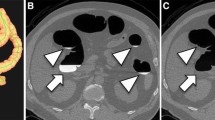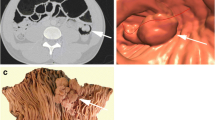Abstract
Purpose
To objectively compare colonic distention at CT colonography (CTC) achieved with manual room air vs. automated low-pressure carbon dioxide (CO2) using a novel automated volumetric quality assessment tool.
Methods
Volumetric analysis was retrospectively performed on CTC studies in 300 asymptomatic adults using an automated quality assessment tool (V3D Colon [beta version], Viatronix). Colonic distention was achieved with room air self-administered to tolerance via hand-held pump (mean number of pumps, 39 ± 32) in 150 individuals (mean age, 59 years; 98 men, 51 women) and via continuous low-pressure automated infusion of CO2 in 150 individuals (mean age, 57 years; 89 men, 61 women). CTC studies in supine and prone position were assessed to determine total colonic volume (luminal gas and fluid). The colonic length along the automated centerline was also recorded to enable calculation of length-adjusted colonic volumes.
Results
The mean total colonic volume (±SD) for individuals receiving room air and CO2 distention was 1809 ± 514 and 2223 ± 686 mL, respectively (p < 0.01). The prone position was better distended in 78.7% (118/150) of cases using room air; whereas, the supine was better in 66.0% (99/150) of CO2 cases (p < 0.01). Using a volume threshold of 2000 mL, 49 (32.7%) of room air cases and 92 (61.3%) of CO2 cases were above this cut-off. The mean length-adjusted colonic volume (mL/cm) for the room air and CO2 techniques was 9.9 ± 2.4 and 11.6 ± 2.6 mL/cm (p < 0.01).
Conclusions
Using automated volumetry allowed quantitative analyses of colonic volumes and objectively confirmed that continuous low-pressure CO2 provides greater overall colonic distention than the manual room air technique at CTC. The supine position demonstrated better distention with CO2, whereas the prone position was better distended with the room air technique.





Similar content being viewed by others
References
Pickhardt PJ, Kim DH (2010) CT colonography: principles and practice of virtual colonoscopy. Philadelphia: Saunders
Pickhardt PJ (2007) Screening CT colonography: how I do it. AJR Am J Roentgenol 189:290
Dachman AH (2006) Advice for optimizing colonic distention and minimizing risk of perforation during CT colonography. Radiology 239:317
Kim DH, Pickhardt PJ (2010) Colonic distention for CT colonography. In: Pickhardt PJ (ed) CT colonography: principles & practice of virtual colonoscopy. Philadelphia: Saunders, pp 131–147
Kim SY, Park SH, Choi EK, et al. (2008) Automated carbon dioxide insufflation for CT colonography: effectiveness of colonic distention in cancer patients with severe luminal narrowing. Am J Roentgenol 190:698
Taylor SA, Halligan S, Goh V, et al. (2003) Optimizing colonic distention for multi-detector row CT colonography: effect of hyoscine butylbromide and rectal balloon catheter. Radiology 229:99
Burling D, Taylor SA, Halligan S, et al. (2006) Automated insufflation of carbon dioxide for MDCT colonography: distension and patient experience compared with manual insufflation. Am J Roentgenol 186:96
Shinners TJ, Pickhardt PJ, Taylor AJ, et al. (2006) Patient-controlled room air insufflation versus automated carbon dioxide delivery for CT colonography. Am J Roentgenol 186:1491
Hung PW, Paik DS, Napel S, et al. (2002) Quantification of distention in CT colonography: development and validation of three computer algorithms. Radiology 222:543
Pickhardt PJ (2006) Incidence of colonic perforation at CT colonography: review of existing data and implications for screening of asymptomatic adults. Radiology 239:313
Pickhardt PJ, Bakke J, Kuo J, et al. (2014) Volumetric analysis of colonic distention according to patient position at CTC: diagnostic value of the right lateral decubitus series. AJR (in press)
Pickhardt PJ, Choi JR, Hwang I, et al. (2003) Computed tomographic virtual colonoscopy to screen for colorectal neoplasia in asymptomatic adults. N Engl J Med 349:2191
Fenlon HM, Nunes DP, Schroy PC, et al. (1999) A comparison of virtual and conventional colonoscopy for the detection of colorectal polyps. N Engl J Med 341:1496
Yee J, Akerkar GA, Hung RK, et al. (2001) Colorectal neoplasia: performance characteristics of CT colonography for detection in 300 patients. Radiology 219:685
Bretthauer M, Thiis-Evensen E, Huppertz-Hauss G, et al. (2002) NORCCAP (Norwegian colorectal cancer prevention): a randomised trial to assess the safety and efficacy of carbon dioxide versus air insufflation in colonoscopy. Gut 50:604
Michel SJ, Pickhardt PJ, Kim DH, et al. (2007) Effect of colonic distention on superiority of supine versus prone views in screening computed tomographic colonography. Clin Imaging 31:325
Buchach CM, Kim DH, Pickhardt PJ (2011) Performing an additional decubitus series at CT colonography. Abdom Imaging 36:538
Khashab M, Pickhardt PJ, Kim DH, et al. (2009) Colorectal anatomy in adults at CT colonography: normal distribution and the effect of age, gender, and body mass index. Gastrointest Endosc 69:AB275
Hanson M, Pickhardt PJ, Kim DH, et al. (2006) Complete versus incomplete optical colonoscopy: Predictive factors based on clinical and virtual colonoscopy findings. Gastroenterology 130:A47
Author information
Authors and Affiliations
Corresponding author
Rights and permissions
About this article
Cite this article
Patrick, J.L., Bakke, J.R., Bannas, P. et al. Objective volumetric comparison of room air versus carbon dioxide for colonic distention at screening CT colonography. Abdom Imaging 40, 231–236 (2015). https://doi.org/10.1007/s00261-014-0206-x
Published:
Issue Date:
DOI: https://doi.org/10.1007/s00261-014-0206-x




